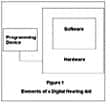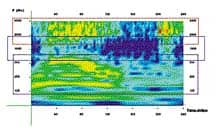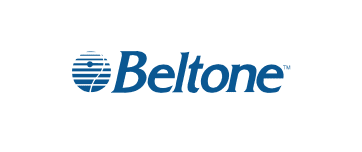Hearing instrument sales declined by 0.7% in 2001 to 1.93 million units. Although, the average dispensing office experienced a unit volume decrease of 2.1%, they realized an overall increase in gross revenues of 7%-9% due to consumer purchases of programmable and DSP instruments. Digital and directional technology, industry consolidation, and forward integration continue to reshape the industry.
About the same—maybe worse. This might be the most accurate description of hearing instrument sales during 2001. According to Hearing Industries Assn. statistics1, net hearing instrument sales in the US decreased by 0.07% in 2001, a unit volume shortfall of about 1400 units. In total, there were 1.93 million aids dispensed in the U.S. during 2001 (Figure 1), and an additional 95,000 units exported. However, when sales from the Department of Veterans Affairs (VA) are subtracted from the statistics, it can be seen that sales for the average dispensing office actually fell by 2.1%—or about 3 hearing aids per dispensing office.
HIA statistics indicate that hearing instrument sales gains by US dispensing offices have been non-existent for the past 3 years (Figure 1). In fact, hearing instrument sales from dispensing offices have not varied by more than 2% (37,000 units) in 4 years. And that spells F-L-A-T.

|
|
|
Alternative Dispensing Routes Gain in Popularity
By now, most dispensing professionals who keep up with industry events are well versed in statistics like the following: 28.6 million people with hearing loss, only 6.3 million people wearing hearing instruments, and a 7-year wait before average consumers address their hearing loss.
The above figures are taken from MarkeTrak consumer survey data, most recently published by Sergei Kochkin in the December 2001 Hearing Review. However depressing the statistics might be, they represent a continuing failure of the hearing industry and dispensing professionals to promote their own cause. MarkeTrak VI2 data indicated that much of the recent sales growth in the hearing instrument market is due to VA and mail order sales. Mail order sales of hearing aids have increased by 91% since 1997 and represented 124,000 units in 2000 (3.5% of the market).2
MarkeTrak VI also asserted that VA sales increased by 83% to make up 8.4% of the market compared to 4.5% of the market in 1997.2 Statistics reported by hearing instrument manufacturers1 concur, indicating that the VA has rapidly become a larger player during the past 4 years; government purchases of hearing instruments totaled 237,000 units in 2001 and now account for more than one-in-every-10 (12.3%) hearing aid sales, according to HIA figures. Much of this is due to the VA’s changes in eligibility benefits. In 1996, Congress passed the eligibility reform act that allowed full coverage of those veterans who had a 10% service-connected disability (previously, a veteran had to have 50% service-connected disability to get a full range of VA services).
Taken together, the above would suggest that about 15% of all hearing instruments dispensed are being sold via non-traditional channels.
Private Dispensing & Market Value in 2001
High performance products and their effects on the market: Despite the lower unit volumes, the higher average selling price (ASP) of digital and programmable instruments and the growing popularity of these instrument types buoyed the gross revenues for the average dispensing professionals by 7%-9% in 2001. Digital instruments now account for 27.2% of all hearing instruments dispensed, while programmable analog instruments accounted for 31.8%. That means a full 59% of all sales—3 in 5 hearing aids—are from the advanced, programmable hearing instrument category (Figure 2).

|
|
|
According to HR figures (which do not account for specially priced aids and include the price of most of the associated services related to dispensing), the average selling price of a hearing instrument was $1,099 in 1997 and $1,600 in 2001, a 45% increase. HR estimates last year’s total retail gross revenues at the dispenser level to be $3.1 billion compared to sales of $2.8 billion in 2000. (Editor’s note: Estimates by HR of average retail gross revenues are derived by applying the price of each instrument type as reported in the annual HR Dispenser Survey3 and extrapolating them to HIA sales statistics1 for those instruments. It is important to note that considerable variations may exist in these estimations due to the predominant practice of “bundling” service and testing fees within hearing instrument pricing (ie, in the HR Dispenser Survey, prices for both instruments and services are usually reported by dispensers as the “hearing instrument price”). Third-party discounts, leasing programs, VA sales, and free aids may affect retail values significantly. Thus, the retail dollar figures are offered here only as a useful gauge for the actual value of the market.)
According to MarkeTrak VI2, the average selling price of a hearing instrument increased by 35% since 1997, and the average sales price of an aid was $1,009 in 2000 (this figure includes the effects of free, discounted, and third-party reimbursed hearing instruments). Extrapolating from this data, the 2000 hearing instrument market at the retail level would have been worth $2.0 billion.
It is apparent that the average price of hearing instruments has risen rapidly in the last five years in response to the availability and popularity of new sophisticated hearing instruments. These average selling price increases have almost certainly influenced consumer purchases, perceptions of value, and expectations.
It’s difficult to overstate the effect that digital and programmable aids have had on everything in the hearing industry—including the ledger sheets of dispensing practices during the last 5 years. Unpublished results from the HR 2001 Dispenser Survey3 suggest that only about 4% of dispensing offices do not offer any kind of programmable or digital aid. HR estimates that digital instruments made up 42% of a private dispensing practice’s gross revenue, while programmable analog aids made up 32% (Figure 3). In other words, about three quarters of an average practice’s income now depends on high performance instruments.
|
The ASP of hearing instruments is expected to continue to increase for the next few years, but these increases should be nowhere near what has been witnessed in the last 5 years—the period when digital instruments were first introduced. The popularity of more economically priced digital aids—many of which are capable of competing favorably with medium-level analog programmable aids—should continue to retard the overall ASP growth of hearing aids.”
On the other hand, what some are calling the “Directional Renaissance” may add more impetus—and value—to the market as a whole, helping to counterbalance the falling prices and rising expectations of the advanced aids.
Hearing instrument styles: Table 1 shows the percentage of hearing instruments dispensed by style and technology type. Overall, the seven most-popular types of hearing instruments fit by dispensing professionals are: 1) Non-programmable full-shell ITEs (14.8% of the market); 2) Programmable full-shell ITEs (10.7%); 3) Non-programmable BTEs (10.3%); 4) Non-programmable ITCs (8.2%); 5) Programmable ITCs (7.6%); 6) Digital BTEs (7.0%); and 7) Digital CICs (6.6%).
The move toward digital and directional instruments are the primary reasons behind a recent surge in BTE hearing instrument use in the US. Since 1998, BTE use has increased by 18.1%, and they are now used in more than one-quarter (25.9%) of all DSP fittings. The growth in BTEs is rivaled only by CICs which have experienced a 33.6% increase in popularity since 1998 due to their use in high-end digital fittings; CICs account for 24.2% of all DSP aids.
Hearing instrument returns: Hearing instrument returns for credit (RFC) were slightly lower in 2001 (19.1%) than in 2000 (19.5%). Table 2 indicates that four of the six most frequently returned hearing instrument types were digital. In fact, one-in-four (24.4%) of all digital instruments dispensed is returned for credit, compared to about one-in-seven non-digital instruments.
Significantly, RFC rates for analog programmable instruments decreased dramatically from 18.9% in 2000 to 15.5% in 2001. In 1997, programmable RFCs were a whopping 24.2%—analogous to the digital instrument RFCs of today. Today, the RFC rates for programmable aids are essentially the same as non-programmable aids.
|
Table 1. Popularity of Hearing Aid Styles |
|||||||||||||||||||||||||||||||||||
|
Percentage of US units dispensed by hearing aid style and technology type. Source: HIA. |
|||||||||||||||||||||||||||||||||||
|
|||||||||||||||||||||||||||||||||||
|
|||||||||||||||||||||||||||||||||||
|
Emerging Trends
Directional hearing aids: One of the clearest trends is the increasing use and proliferation of directional hearing instrument models. The directional instrument renaissance is in full swing. While there are no market statistics on the sales of directional instruments, virtually all new programmable and digital product lines contain some provision for directionality. In 1997, there were only two in 45 programmable/DSP lines that offered a directional option. By January 2001, 58 of the 101 programmable and DSP instrument lines offered a directional option in one or more models.4
|
Table 2. Returns for Credit |
||||||||||||||||||||||||||||||
|
Percentage of US units returned by hearing aid style and technology type. Source: HIA. |
||||||||||||||||||||||||||||||
|
||||||||||||||||||||||||||||||
|
While hearing instrument manufacturers are only now beginning to generate objective data showing that signal processing algorithms may be effective in improving speech-in-noise, directional hearing instruments remain the most universally accepted remedy for solving the age-old problem of hearing in noise.
Industry consolidation and forward integration: The consolidation movement continues, and many acquisitions took place during 2001. While most experts in the field anticipate at least one more “blockbuster” hearing instrument manufacturer merger/acquisition in the next two years, manufacturers and their parent companies concentrated primarily on forward integration in 2001 by acquiring, or otherwise financially aligning themselves with, conglomerate dispensing chains. A few of the more notable acquisitions and agreements are shown in Table 3 (page 19).
For those of you keeping score at home, Table 3 shows 11 instances of forward integration, where a manufacturer or retail chain affiliated itself (via acquisition, distribution agreement, etc) with an existing chain of dispensing offices.
|
Table 3. Acquisitions & Agreements, Dec. 00-present |
| * Phonak Group purchased the Argosy/ Lori/Unitron Group;
~ GN ReSound purchased ICS Medical (VNG/ENG equipment manufacturer) # GN ReSound purchased Bass & High (Spanish chain retailer); * Magnatone acquired Perfect Ear; # The formation and building of the Audibel and AVADA chains (affiliated with Starkey and William Demant, respectively) attracted a number of dispensing offices (including several ex-Beltone offices); # Amplifon, owner of Miracle Ear, purchased Acoudire BV (a leading Dutch retail distributor); # GN ReSound acquired Dana Japan (their Japanese distributor). # Phonak Group acquired Hansaton (Austrian distributor). # Siemens entered into an agreement with HEARx; # GN ReSound entered into an agreement with Sonus; # Sonic Innovations purchased ME-Hearing (Australian dispensing chain); # Hearx and Helix agreed to merge and to form HEAR USA. # William Demant Holding purchased 49% of American Hearing Aid Associates (AHAA); # GN ReSound acquired 25% of Ultravox Holdings (UK/Irish retailer); * Interton purchased Authorized Hearing Systems; # Helix finalized an agreement with National Ear Care Plan; > Phonak acquired Telex wireless CROS technology; ~ William Demant purchased Tremetrics audiometer division; > Plantronics acquired Ameriphone; * Starkey and William Demant embarked on joint wireless consortium project; * Telex prepares hearing instrument group for sale. Source: HR and Carnegie Research5 |
| Key to aquisitions/agreements/affiliations: * Manufacturer + Manufacturer oriented # Manufacturer + Chain retailer oriented ~ Manufacturer+ Special equipt. mft. oriented > Assistive device oriented |
Back to the Future with wireless technology? Ironically, the miniaturization of transmission and Bluetooth/wireless technology may beckon in a revival of body-worn processors used for enhanced digital signal processing. Several industry engineers maintain that moving from today’s in-the-ear chips to a system in which sound is received by the hearing aid, beamed to and processed within a small device (disguised as a pager or cell phone) clipped to a person’s belt, then beamed back up to the ear for delivery from a custom earmold may be the next “big leap” in hearing instrument technology. Such a system could potentially solve a number of problems, including many of today’s power, processing, packaging and remote control constraints. It could also hail the advent of “smarter” directional and FM strategies, integrated binaural processing, and a greater separation between microphones (and/or remote, detachable mics). These devices could also potentially offer truly open-system processing capabilities, among other advantages.
Proposed Hearing Aid Rule revision: The Food and Drug Administration (FDA) has withdrawn its proposed revision of the federal hearing aid regulations for its 2002 fiscal year. In December, Secretary of Health and Human Services Tommy Thompson announced that a revision is not on the FDA’s agenda any time soon.
In place since 1977, these rules govern the dispensing of hearing instruments. It is believed that the FDA proposed revision, as currently drafted, would leave the necessary professional credentials held by dispensing professionals, as well as the required tests in a hearing evaluation, up to individual states. It now appears unlikely that any revision of the federal regulations governing dispensing will be undertaken in the foreseeable future.
Conclusion
Despite the flat unit volumes, gross revenues of the average dispensing office increased by about 7%-9% in 2001 due to the increased popularity of digital and programmable hearing instruments, which enjoy a higher average selling price. In the first quarter of 2002, hearing instrument sales have shown few signs of improvement, and it appears likely that unit volumes will remain within a few percentage points of 2001 levels, while the continued gains in dispensing high performance products are likely to increase gross revenues of dispensers by 5%-8%.
Worldwide, it is estimated that the worldwide hearing instrument market will grow by 3.5% in unit volume and 5.5% in value each year through 2010.5 In 2001, 2.1 million hearing aids were dispensed in Europe, representing a net unit volume growth of 3.3%, while the value of the market increased by 8.2%.6
References
1. Hearing Industries Association: Quarterly Statistics Report for the Fourth Quarter 2001. Alexandria, Va. HIA, 2002.
2. Kochkin S. MarkeTrak VI: The VA and direct mail sales spark growth in hearing aid market. Hearing Review. 2001; 8(12):16-24,63-65.
3. Strom K. The HR 2000 dispenser survey. Hearing Review. 2001; 8(6): 20-42.
4. Strom K. A perspective on transformations in hearing health care due to high performance hearing instruments. In: G Matsui, T Lemon’s (eds) A Special Report on New Hearing Instrument Technology. Supplement to Hearing Review. 2001; 8(4):32-34.
5. Clemons M. Industry Report: Hearing Aids. Copenhagen, Denmark: Carnegie Research, October 4, 2001.
6. Interconnect Research. 10% of the population suffers from hearing impairment—European market for hearing instruments growing. Press release. Munich: Interconnect Consulting Group. 2001.




